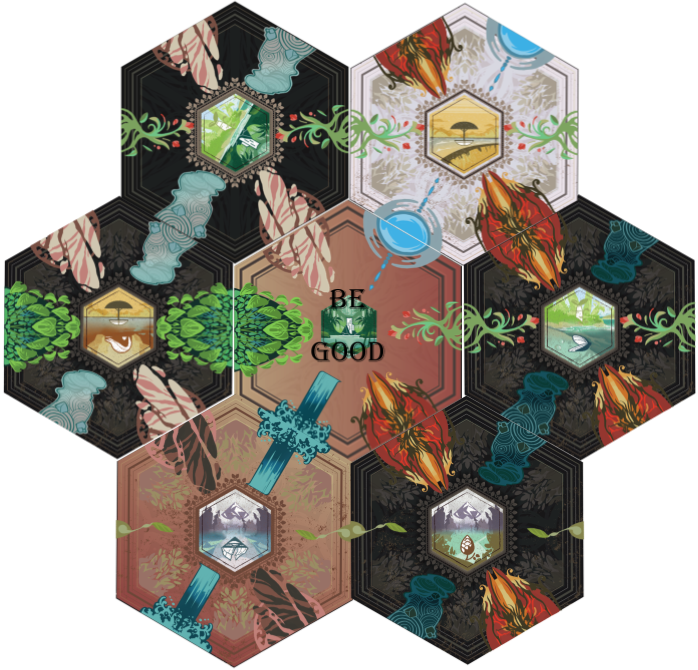
Declare a situation that you are creating in your life that you wish to understand better.
Select one of the nine True Self Territory tiles that best signifies the value you are pursuing within that situation. Place that tile in front of you.
Adopt the six Animal Moods shown on the tile, placing them around the True Self Territory tile.
Then write six statements that represent each animal’s perspective within you.
In this example layout, the Imperative to Be Good was selected. The player wished to prioritize their Kind Elephant (“Put others first.”) and Calm Bear (“It will be all right.”), placing them first. This allowed the unique additions of Awake Otter (“Your powers are awesome.”) and Adoring Bat (“Love is a dance.”), whose statements also fit with the player’s views of their situation. In order to create a congruent set of Tels between all Animal Moods, the Energetic Wildebeest (“Life can be hard.”) and Discouraged Shrew (“Nobody cares about me.”) were the only Moods that fit. Their statements, though less positive, were helpful to the player’s full awareness of their perspective on the situation at hand.
Strategy 1
Pick your first two or three moods by name from the Mood Chart. This strategy helps to prioritize a few moods that are most important to you, even if they may create inner turmoil overall.
Strategy 3
Select your best and worst feelings that are prompted by the situation and place them on opposite sides of the Imperative. Then find other Moods that help to create congruence. This may clarify the challenge of finding peace while overly identified with incompatible moods.
Strategy 2
Start with exploring Tels and pick your moods from those that share common inner states. This strategy helps you to have inner congruence even if each Mood is not your favorite.
Strategy 4
In addition to your Imperative, choose a True Self Goal and place as many of the moods as possible that share the center icon of that True Self Territory. This may shed light on the turmoil within that may be leading you toward your higher self.
-
by Thomas Yeomans, Ph.D.
Roberto Assagioli was fond of saying to his students “practice makes perfectly imperfect”. In this statement, usually accompanied by his characteristic chuckle, he touched on several central aspects of psychosynthesis.
First is the importance of practice itself, the consistent “doing” of certain exercises that support the process of psychosynthesis within oneself over time.
Second is the paradoxical affirmation of our “perfect imperfection” as a way of pointing to the fact of continual growth, that we are never “finished” in an infinite universe, and that this is “perfectly” all right.
Third is that we can actively cooperate with our development and can choose to practice in ways that enrich and deepen our lives. We don’t have to wait for this to happen, but rather, through practice, we can use our awareness and will to heal and strengthen our personalities so they gradually become more coherent and creative instruments for the expression of our true Selves.
And fourth is that there actually is a perfection in this process of psychosynthesis, of “life living itself more deeply”, a perfection that is both mysterious and orderly, that is beyond us and within us, and that we touch both together and alone. This perfection we can gradually realize in our daily lives through conscious practice, and, of course, through simply living our given lives to the full, which is the most central practice of all.
-
Some of the points you might want to consider are:
1. With which animal am I identified most of the time?
2. Were different animals predominant in the various parts of the situation? What has been the relative activity of each?
3. What were the valuable qualities and the limitations of each? How did each help me or get in my way?
4. Were there any conflicts between them?
5. What part did I take in harmonizing and directing them?
You can either consider these points during the review itself, or if this gets in your way, you can think about them at the end of the review.










